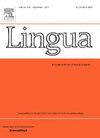名词常用语在可接受性判断、自定节奏阅读和眼球追踪三种阅读模式下的研究
IF 1.3
3区 文学
0 LANGUAGE & LINGUISTICS
引用次数: 0
摘要
本研究旨在研究在可接受性判断、自定节奏阅读和眼球追踪实验三种不同的阅读实验范式中对(名义)流行句的阐述。名义共同句(nc),如[DP1墙的图片]是[DP2暴乱的原因],代表了一个具有挑战性的现象,至少有两个原因:(i)它们可以分为两种亚型,即规范和逆nc,与dp的不同顺序有关(分别,规范形式的[DPsubject是DPpredicate]与逆形式的[DPpredicate是DPsubject]);(ii)这两个子类型与同一类型的字符串相关联[DP是DP],尽管它们的底层结构完全不同。我们的研究结果表明,在离线范式中,即在可接受性判断中,没有出现差异。另一方面,自定速阅读任务和眼动追踪实验显示这两种类型的神经网络存在不对称性,反向神经网络的处理成本更高。更具体地说,在反向nc中,DPsubject被观察的次数更多,时间更长。此外,在眼球追踪实验中,当比较动词后位置的动词后主语和动词后谓语时,即使考虑了所用单词的长度和频率,句子结构也能很好地预测总阅读时间和回归路径持续时间。这些结果有力地支持了一种假设,即句法结构是在同一串词汇类型的条目之间产生不同阅读模式的主要因素。本文章由计算机程序翻译,如有差异,请以英文原文为准。
An investigation of nominal copular sentences in three reading paradigms: Acceptability judgments, self-paced reading, and eye-tracking
This work aims to investigate the elaboration of (nominal) copular sentences in three different experimental paradigms involving a reading task: an acceptability judgment, a self-paced reading and an eye-tracking experiment. Nominal copular sentences (NCs), such as [DP1 The picture of the wall] is [DP2 the cause of the riot], represent a challenging phenomenon for, at least, two reasons: (i) they can be distinguished in two subtypes, namely canonical and inverse NCs, related to the different order of the DPs (respectively, [DPsubject is DPpredicate] in canonical form vs. [DPpredicate is DPsubject] in inverse form); (ii) these two subtypes are associated with one and the same type of string [DP is DP], although their underlying structure is completely different. Our results show that no differences emerge in the off-line paradigm, i.e. in the acceptability judgments. On the other hand, the self paced-reading task and the eye-tracking experiments show an asymmetry between these two types of NCs, with higher processing costs for inverse NCs. More specifically, the DPsubject is looked at more often and for longer times in inverse NCs. Moreover, when comparing the DPsubject to the DPpredicate in postverbal position in the eye-tracking experiment, sentence structure resulted as a good predictor for total reading time and regression path duration, even after taking into account the length and frequency of the words used. These results strongly support the hypothesis that syntactic structure is a primary factor in generating a different reading pattern between the same string of lexical types of items.
求助全文
通过发布文献求助,成功后即可免费获取论文全文。
去求助
来源期刊

Lingua
Multiple-
CiteScore
2.50
自引率
9.10%
发文量
93
审稿时长
24 weeks
期刊介绍:
Lingua publishes papers of any length, if justified, as well as review articles surveying developments in the various fields of linguistics, and occasional discussions. A considerable number of pages in each issue are devoted to critical book reviews. Lingua also publishes Lingua Franca articles consisting of provocative exchanges expressing strong opinions on central topics in linguistics; The Decade In articles which are educational articles offering the nonspecialist linguist an overview of a given area of study; and Taking up the Gauntlet special issues composed of a set number of papers examining one set of data and exploring whose theory offers the most insight with a minimal set of assumptions and a maximum of arguments.
 求助内容:
求助内容: 应助结果提醒方式:
应助结果提醒方式:


